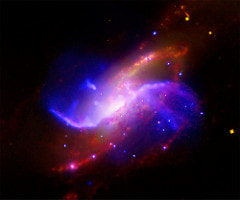 Creative Commons photo by the NASA Marshall Space Flight Center Creative Commons photo by the NASA Marshall Space Flight Center Note: this post appeared on another blog I run, but I thought I would share it here as well since it is related to the theme of creativity and storytelling. This fall, two space-faring shows debuted. One of them arrived to much fanfare and buzz as it was the next iteration of the famed Star Trek legacy. The other one, while hyped, premiered after an NFL game on Fox to much less confetti and pizzazz. It would be easy to write about the technical advancements of Star Trek: Discovery, the beautiful filming, the early focus on the Klingons rather than the Federation or the bold move to debut the show on traditional television and then move it to streaming video in an effort to be on the new wave of entertainment consumption. But, despite all the hoopla, I wasn’t that impressed, and it’s not because I’m a fair-weather friend of the franchise. While too young to view the original series on TV when it debuted, I’ve watched all the movies (even the bad ones) and sampled each of the TV shows. The problem is that the new series is too much like the movies, which are fun to be sure, but best in small doses. The first episode seemed to me more enamored with the technology than with the characters. And, with my lack of desire to sign-up for yet another streaming service, the move simply signed its fate in my book. On the other hand, The Orville, which is created to be a strange brew of science fiction and comedy (an updated TV version of Galaxy Quest), shouldn’t work at all. Science fiction aficionados (OK, nerds or geeks is probably more appropriate here. I use these terms lovingly, as my sci-fi Nerd Card is completely up to date) don’t want to laugh, unless this joke has something to do with a pun about warp signatures, and those who like comedies don’t care about the technology being accurate, just funny (Spaceballs anyone?). Yet, the thing is that Seth MacFarlane makes it work somehow. The secret of his success is that while he knows funny, he clearly appreciates the science fiction genre as well. Bringing on people like executive producer Brandon Braga and directors like Jon Cassar and Jonathan Frakes, shows MacFarlane is serious about giving the show some street cred. For better or worse, the show checks off the requisite boxes: Uplifting Theme Music — Check Smooth Tech Design — Check Juvenile Humor — Double Check Yet for every sophomoric reference to fooling around or going to the bathroom, you have a flip side of the narrative coin in which characters chart the murky waters of themes such as gender empowerment and identity, the battle of religion over science, animal cruelty, time travel and whether killing a few to save many is a justifiable sacrifice or makes you someone without a conscience. Even some of the smaller elements show an attention to detail. The green Kermit the Frog on Capt. Mercer’s desk gets all the focus, but if you look closely, you will see the wooden model of the Wright Brothers’ biplane, an obvious homage to the ship’s namesake. The best part of the is one most of us don’t think about. For decades, we have always revered the characters in science fiction tales because they are much better people than we would ever be. They are brave and composed in the face of situations that would make us lose our lunch or wet our pants. Imagine, however, if instead of pulling your candidates for space exploration not from the ranks of NASA, but the chairs and couches of “Central Perk.” If you think about it, the goofy humor and silly antics sprinkled through each episode make it more like an episode of Friends than a Shakespearean cast with grown-up onesies and phasers (again, I loved ST:TNG as a kid). The anachronistic jokes and references might seem a bit contrived, but those in the Star Trek timeline always like to make a pit stop in whatever generation the show/film was written (using the Beastie Boys “Sabotage” as “classical music” in Star Trek Beyond is just the latest example). Sure Malloy and LaMarr act at times like irrepressible teenagers on the bridge and Mercer and Grayson are the adults whose own fractured relationship is the source of joking and scuttlebutt, but Bortus and Issac provide logic in times of peril and Kitan is this generation’s Wesley Crusher, filled with youthful energy, but unsure of her own ability to lead. With supporting actors like Larry Joe Campbell and Penny Johnson Jerald (no stranger to the Star Trek world herself), you’ve got a good crew running the ship. And MacFarlane and Co. has been smart enough to engineer a few guest appearances make the show even more fun. The Orville has no illusions about what it is — a weekly science fiction serial that’s determined to explore the universe even if it slips on a banana peel along the way. In a TV and film universe where our space travelers are heroes who stare down danger with a steely glare before setting phasers to kill, The Orville is, simply put, science fiction for the rest of us.
0 Comments
Leave a Reply. |
AuthorI've been writing stories and taking photos since I was old enough to hold a pencil and stand behind a tripod. Archives
February 2024
Categories
All
|
 RSS Feed
RSS Feed